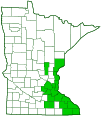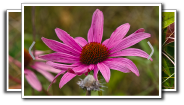hickory hairstreak
(Satyrium caryaevorus)
Conservation • Description • Habitat • Ecology • Distribution • Taxonomy
Conservation Status |
|
|||||||
| IUCN Red List | not listed |
|||||||
| NatureServe | N4 - Apparently Secure SU - Unrankable |
|||||||
| Minnesota | not listed |
|||||||
Description |
||
Hickory hairstreak is a small to medium-sized, gossamer-winged butterfly. It occurs in the eastern United States from Vermont to Minnesota south to New Jersey and Missouri, and in adjacent Canadian provinces. It is uncommon in Minnesota, where it is at the northwest extent of its range. It is found from late June through July in open fields adjacent to deciduous and mixed forests, and in forest clearings. It is rarely seen as it spends most of its time high in trees. Adults have a ⅞″ to 1⅜″ (22 to 35 mm) wingspan. The upper side if the wings are rarely seen because this butterfly perches with wings closed and is rarely seen from above. Like other hairstreaks, the hindwing has two tails near the tip. The shorter, upper tail is very short and often does not look at all like a tail. The underside of both wings is light brown with a thin dark line on the outer margin. On the forewing there is a row of narrow submarginal spots and a row of larger postmedial spots. The submarginal spots are outlined with white just on the inside. The postmedial spots on the forewing are rectangular, outlined with white on both the inside and outside, and joined together to form a continuous band. There is also a similar but incomplete medial band on each wing consisting of just two conjoined spots. On the hindwing the postmedial spots are similar but smaller. They are smallest at the bottom becoming progressively larger toward the top. The top spot is as large as the medial spots, and is offset between the postmedial and medial bands. There is a large, light blue spot below the tail and a long, narrow, orange spot on the inner margin at the anal angle. The blue spot is not topped with orange. It extends nearly to the postmedial band. The marginal spot between the tails has a prominent orange cap. The orange cap is smaller than the black spot it covers. The next three spots may have smaller orange caps gradually decreasing in size and fading. The eyes are black. The antennae are striped black-and-white and have an orange-tipped club. The caterpillar is wide, somewhat flattened, yellowish-green, and short, no more than ¾″ long. There is a pair of white longitudinal lines in the middle (subdorsal), and a white line on each side below the breathing pores (spiracles). The area between the subdorsal lines is darker green. On each abdominal segment there is a single, prominent, oblique line between the subdorsal and subspiracular stripes. |
||
Size |
||
Wingspan: ⅞″ to 1⅜″ (22 to 35 mm) |
||
Similar Species |
||
| Banded hairstreak (Satyrium calanus) is very similar in appearance. The postmedial band on the forewing is outlined in white boldly on the outside, narrowly on the inside. The offset spot at the top of the postmedial band is narrower than the medial spots. The light blue spot at the anal angle extends only slightly beyond the adjacent spot. The orange cap on the spot between the tails is as large or larger than the black spot it covers. | ||
Habitat |
||
Open fields adjacent to deciduous and mixed forests, forest clearings |
||
Ecology |
||
Season |
||
One generation per year: late June through July |
||
Behavior |
||
Adults perch with their wings closed above their body. They are rarely seen with their wings spread. |
||
Life Cycle |
||
|
||
Larva Hosts |
||
Leaves of mostly bitternut hickory; also shagbark hickory, black walnut, and butternut; occasionally oak and ash. |
||
Adult Food |
||
Flower nectar |
||
Distribution |
||||
|
Sources |
|||
| 7/1/2022 | ||||
Occurrence |
||||
|
||||
Taxonomy |
|||
Order |
Lepidoptera (Butterflies and Moths) | ||
Superfamily |
Papilionoidea (butterflies) | ||
Family |
Lycaenidae (gossamer-winged butterflies) | ||
Subfamily |
Theclinae (hairstreaks) | ||
Tribe |
Eumaeini | ||
| Subtribe | Eumaeina | ||
Genus |
Satyrium (satyrid hairstreaks) | ||
| Subgenus | Satyrium | ||
Synonyms |
|||
Satyrium caryaevorum |
|||
Common Names |
|||
hickory hairstreak |
|||
Glossary
Anal angle
In insects: The angle at the corner of a wing formed where the outer and inner margins meet.
Spiracle
A small opening on the surface of an insect or arachnid through which it breathes.
Visitor Photos |
|||||
Share your photo of this insect. |
|||||
| This button not working for you? Simply email us at info@MinnesotaSeasons.com. Attach one or more photos and, if you like, a caption. |
|||||
Greg Watson |
|||||
Harvestman with a Hickory Hairstreak |
|||||
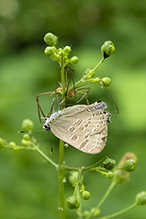 |
|||||
Mike Poeppe |
|||||
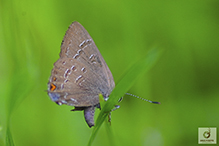 |
|||||
Cary Coop |
|||||
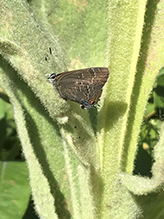 |
|||||
Scott Leddy |
|||||
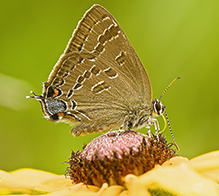 |
|||||
MinnesotaSeasons.com Photos |
|||||
|
|||||

Visitor Videos |
|||
Share your video of this insect. |
|||
| This button not working for you? Simply email us at info@MinnesotaSeasons.com. Attach a video, a YouTube link, or a cloud storage link. |
|||
Other Videos |
|||
| HICKORY HAIRSTREAK Satyrium caryaevorus Rob Curtis |
|||
About
Aug 7, 2019 Satyrium caryaevorus HICKORY HAIRSTREAK, MCClaughery Springs FP, IL. 7/1/2019 |
|||

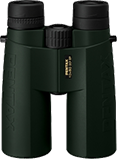
Created: 4/17/2020
Last Updated:
